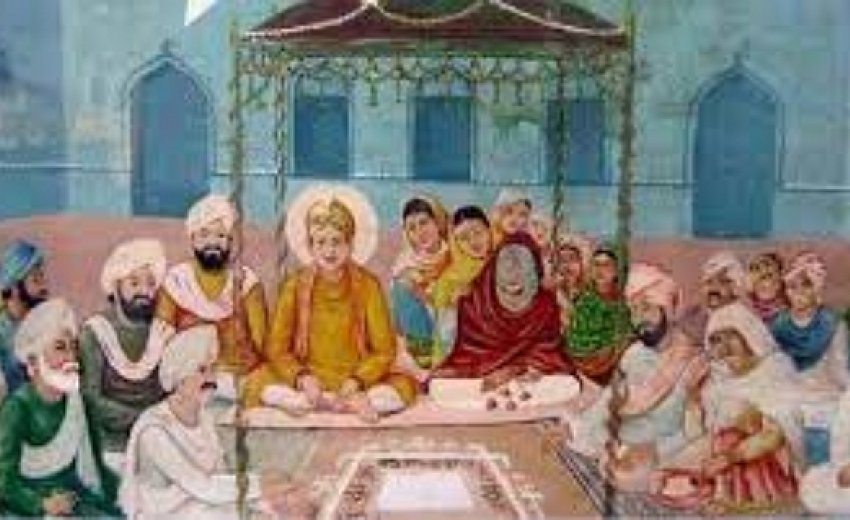Panjabi weddings around the world are famous for its celebratory, cultural rhythm of songs and dances, dazzling clothes and feasting. But in the heart of this outward celebration is an innate connection with the Spiritual that solemnizes the Sikh weddings. The liveliness and celebratory spirit around these weddings is completed only by performing a ceremony in which the wedding couple is required to circumambulate around the Guru Granth Sahib along with a simultaneous recitation of a composition from the Guru Granth Sahib, identified as Lavan. In the Sikh perspective, a Sikh wedding is not just a meeting of two bodies but a coming together of two hearts that unite in the spiritual journey to ultimately be one with the all-pervading and eternal Force (IkOankar).
Lavan: An Introduction
The Lavan composition comprising four stanzas of a chant was revealed by Guru Ramdas, the fourth Guru of the Sikhs. These stanzas are recorded on pages 773-774 in the Guru Granth Sahib. Chants are a form of writing with specific poetic dimensions in which feelings of separation, yearning, longing and spiritual union are described. They are recorded under Rag Suhi, a musical mode of devotion and love. They have popularly come to be known as Lavan, primarily because the word lav gets repeated in all of them, though they are not titled as Lavan per se in the Guru Granth Sahib.
Making of The Sikh Wedding Tradition of Lavan Phere
When did Guru Ramdas reveal Lavan? How did the singing of Lavan eventually become a tradition amongst the Sikhs? How were weddings performed before this tradition was initiated? These are some interesting questions that give us a peep into the Sikh history.
How did Guru Ramdas reveal Lavan? Sant Kirpal Singh narrates a legend that a Brahmin priest refused to perform the marriage ceremony of a poor Sikh as he was unable to afford the expenses required for the wedding rituals. The Sikh approached Guru Ramdas and shared his anxiety. In return, the Guru invited the bride and groom’s family on the day decided for the wedding to his court. When the families arrived at the Guru’s court, the Guru was giving instruction to another Sikh, pertaining to the true spiritual union with IkOankar. It was at that moment when the Guru revealed these stanzas, now known as Lavan, and performed the wedding of the poor Sikh’s daughter and the bridegroom. Therefore, the tradition of reciting Lavan during the Sikh wedding ceremony must have started since the time of Guru Ramdas. Accordingly, the tradition of circumambulation around the Guru Granth Sahib must have started after the compilation of the Guru Granth Sahib in 1604.
Following this tradition, Guru Hargobind, the sixth Guru (1595-1644) too recited these stanzas loudly in the congregation gathered for the wedding of his daughter Bibi Viro (born 1615) as per ‘Gur Bilas Patshahi 6.’
Though there is enough clarity regarding continuation of the Lavan tradition with Guru Ramdas, it is interesting that some historical sources suggest that the Sikh wedding tradition even before Guru Ramdas had its uniqueness. According to Giani Kartar Singh Khalsa, Guru Nanak had himself written the Mul Mantra (the opening verse in the Guru Granth Sahib) on a piece of paper, placed it solemnly on a short wooden platform, and performed circumambulation around it. He further suggests that the third Guru, Guru Amardas (1479-1574), strengthened the tradition by performing the marriage of one of his Sikhs, Bhai Sachan Sach in accordance with the Sikh principles. Guru Amardas had revealed the composition Anand. The Lavan ceremony is closed with a recitation of six stanzas from this composition. In fact, in the present, it has become customary to sing Anand towards the closing of any ceremony just before performing ‘Ardas’, a supplication to IkOankar.
Principal Satbir Singh also describes an incident when the Hindal’s brother wanted to marry his daughter. The Brahmin priest refused to perform the wedding according to the Hindu custom as Hindal was a disciple of Guru Amardas. Thereafter, Guru Amardas had asked Hindal to follow the new Sikh wedding custom of Anand. It may not be wrong to suggest that the Lavan ceremony is also referred to as Anand Karaj; the name may have come from the custom of Anand itself.
Bhai Vir Singh, in a way, explains how the tradition moved forward from one Guru to another Guru. He suggests that the second Guru, Guru Angad, had renounced the Vedic rituals and followed the Sikh principles during wedding ceremonies; Guru Amardas revealed Anand, and thus the custom of Anand (Karaj) prevailed. This was followed by the practice of reciting Lavan and the implementation of the wedding custom as prescribed by Guru Ramdas. This practice further became prevalent during Guru Arjan’s time. Later, the Sikhs followed the ceremony in accordance with the Sikh custom as evident from Bhai Santokh Singh, who had married his daughters Bibi Khem Kaur and Bibi Maiman Kaur by performing the traditional Sikh supplication (Ardas) in the presence of the Guru Granth Sahib.
Text and Meaning
What comprises the four stanzas of Lavan? What do they signify?
The four stanzas of Lavan move forward in a stepwise progression of a seeker’s journey who longs for a union with IkOankar.
The first lav is the first step towards this union. The seeker takes support of the Divine-principle of Nam as affirmed in the Guru Granth Sahib. Interestingly, the first lav is an initiation of the Sikh customs, as the terminology of the Sikh faith replaces the terminology of the Sanatan tradition. Words like Satiguru/Guru, Bani, Nam substitute words like Brahma, Ved, dharam.
ਬਾਣੀ ਬ੍ਰਹਮਾ ਵੇਦੁ ਧਰਮੁ ਦ੍ਰਿੜਹੁ ਪਾਪ ਤਜਾਇਆ ਬਲਿ ਰਾਮ ਜੀਉ ॥
The Bani is the Ved of Brahma, embrace dharam; (through this) sins have been caused to be forsaken; (I) devote to the dearest Ram. (Literal Translation)
The eternal Wisdom has affirmed that the Bani itself is the Divine scripture; through this, enshrine the Divine-principle of Nam in the mind, which removes all transgressions. I adore the dearest IkOankar. (Interpretive Transcreation)
Having taken the first step towards the spiritual union, the seeker in the second step (lav), renounces ego, clears the heart, and begins to perceive IkOankar as all-pervading:
ਨਿਰਭਉ ਭੈ ਮਨੁ ਹੋਇ ਹਉਮੈ ਮੈਲੁ ਗਵਾਇਆ ਬਲਿ ਰਾਮ ਜੀਉ ॥
ਨਿਰਮਲੁ ਭਉ ਪਾਇਆ ਹਰਿ ਗੁਣ ਗਾਇਆ ਹਰਿ ਵੇਖੈ ਰਾਮੁ ਹਦੂਰੇ ॥
Mind has become fearless, (free) from fears; (the true Guru has) removed the filth of ego; (I) devote to the dearest Ram.
(The human-bride) has acquired reverence (for Hari), sung the virtues of Hari; sees Hari-Ram as present (before her).
(Literal Translation)
The eternal Wisdom has freed the seeker from all fears, and the filth of their ego has been removed. I adore the dearest IkOankar.
The seeker has cleansed their mind by cultivating reverence for IkOankar and by reflecting on IkOankar’s virtues. Now, the seeker perceives IkOankar everywhere. (Interpretive Transcreation)
Steadily, in the third step, the seeker becomes detached from material possessions and is imbued with the Nam in the company of those who are yearning to be one with IkOankar. In this lav stress has been laid on the company of truth-oriented beings who are desirous of union with IkOankar:
ਸੰਤ ਜਨਾ ਵਡਭਾਗੀ ਪਾਇਆ ਹਰਿ ਕਥੀਐ ਅਕਥ ਕਹਾਣੀ ॥
ਹਿਰਦੈ ਹਰਿ ਹਰਿ ਹਰਿ ਧੁਨਿ ਉਪਜੀ ਹਰਿ ਜਪੀਐ ਮਸਤਕਿ ਭਾਗੁ ਜੀਉ ॥
Union of saintly beings of Hari (has happened), very fortunate ones have found Hari; (I) devote to the dearest Ram.
(They) have found the immaculate Hari, have sung virtues of Hari; uttered the Bani of Hari with the mouth. (Literal Translation)
Those fortunate seekers have found IkOankar by meeting the truth-oriented beings. I adore the dearest IkOankar.
Those seekers, who sang the praises of IkOankar, and reflected on the virtues of IkOankar, have found IkOankar, who sanctifies the mind. (Interpretive Transcreation)
In the end, the fourth lav describes the final union of the seeker with IkOankar and how the seeker attains wisdom and begins to experience the ever-joyful state. The seeker now excels in spiritual bliss and a state of equipoise by enshrining Nam in the heart:
ਹਰਿ ਪ੍ਰਭਿ ਠਾਕੁਰਿ ਕਾਜੁ ਰਚਾਇਆ ਧਨ ਹਿਰਦੈ ਨਾਮਿ ਵਿਗਾਸੀ ॥
ਜਨੁ ਨਾਨਕੁ ਬੋਲੇ ਚਉਥੀ ਲਾਵੈ ਹਰਿ ਪਾਇਆ ਪ੍ਰਭੁ ਅਵਿਨਾਸੀ ॥੪॥੨॥
Hari-Prabhu, the Master, has created the task; with Nam in the heart, the human-bride has bloomed.
Servant Nanak says: Through the fourth lav, (the human-bride) has found the indestructible Hari-Prabhu.4.2. (Literal Translation)
In this way, IkOankar has accomplished the auspicious task of the seeker’s union; with Nam in their heart, the seeker has bloomed with bliss.
At the end of the stanza, by using the signature 'Nanak,' Guru Ramdas states: In the fourth step of their journey, the seeker has realized the eternal IkOankar. 4.2. (Interpretive Transcreation)
Though the text of Lava refers to the union of the seeker with IkOankar, yet in the context of the Sikh wedding ceremony, ‘the seeker’ here applies to ‘the wedding couple’ taking part in the ceremony. Thus, according to the Sikh principles, the wedding is considered as coming together of the wedding couple to sing, contemplate, and enshrine virtues of IkOankar. By doing so, while committing to take the journey of life together, they unite and become one with IkOankar. Guru Ramdas, through Lavan, reminds the seekers that the customary practice of marriage can be solemnized only by connecting with IkOankar. This is the true significance of these traditional practices that he reveals to us through these compositions.
Challenges in Translating the Lavan
Translation is a tool that bridges the gap between languages and enables cultural interaction. It allows languages to communicate amongst themselves.
The Guru Granth Sahib Project under the aegis of Sikh Research Institute (U.S.A.) is a global initiative in which translation of the Guru Granth Sahib is being carried out. While translating Lavan several challenges were met. Some of these challenges have been discussed as follows:
One is immersed in feelings of devotion and love on listening to Lavan being sung during the wedding ceremony or otherwise. This can be experienced, in its neatness, only in the original or the source language in which the composition has been revealed. Therefore, the task of translating this composition into English is quite intricate. Nevertheless, expressions like yearning for the Beloved, deep emotions of love, and spiritual bliss have been brought forth with equal passion to the readers in English as in the original.
In the translation certain words from the Indic culture and those representing the Sikh contexts have also been retained, including the word lav (literally, round or circumambulation) so that the reader becomes familiar with the opulent vocabulary of the Guru Granth Sahib.
At the same time, the original pattern of the recurring words that lends its musicality has been retained in the translation. Utmost care has been taken to retain the closeness and authenticity of the original text in the literal translation with respect to the linguistic and grammatical pattern of the source text. Also, the translation of idioms has been closely translated in order to provide a sense of metaphor used in the source language to the reader. It has been replicated in its honesty in the targeted text. Therefore, the use of parentheses and additional words are visible in places. The complicated concerns have been addressed through an exhaustive use of footnotes explaining any diversion, if at all, from the main text. The very idea of the interpretive transcreation that follows the literal translation is to fill the gap between the source text and the literal translation with clarifications and explanations.
Despite all these challenges, the rhythm of this beautiful composition resonates within the heart of the listener while reading the translation. Its recitation and reflection are extremely stimulating and exalting. On experiencing the love of IkOankar, the seeker’s heart begins to rejoice in spiritual bliss. This is how the wedding couple begins their new life, completely imbued in Love. True marriage takes place when the couple becomes one, a single soul inhabiting two bodies.
They are not said to be husband and wife who get together physically and sit.
Rather, those who have one soul in two bodies are called husband and wife. -Guru Granth Sahib 788
Note: The content has been extracted from the translation work in progress of Lavan under the Guru Granth Sahib Project. This will be published soon at: https://app.gurugranthsahib.io/
Dr Jaswant Singh & Dr Ishmeet Kaur
Jaswant Singh is a scholar of Sikh Studies. His immense love for Gurbani propels him to read, reflect, research, and share Gurbani’s wisdom and understanding with the wider community. He currently serves as the Director of Gurbani Research at the Sikh Research Institute (USA) and Content Lead of The Guru Granth Sahib Project. He worked at the Sikh Centre (Singapore) conducting various courses on Guru Granth Sahib, Sikh religion and history. He co-founded AWAT and worked as its Chief Editor. He has published several books and articles in English and Panjabi. He holds a Master’s degree in Religious Studies and a Doctorate in the linguistics of Guru Nanak Bani.
Ishmeet Kaur is an educationist, author, and poet. She teaches at the Centre for English Studies at Central University of Gujarat, Gandhinagar. She is also translating and transcreating compositions for The Guru GranthSahib Project of the Sikh Research Institute. She was nominated as an Inspired Teacher for the President of India Inspired Teacher’s Programme in 2015. Her interest and research lie around the literature of margins, social movements, and studies of violence and trauma. She has published several books and articles in many National and International Journals.



